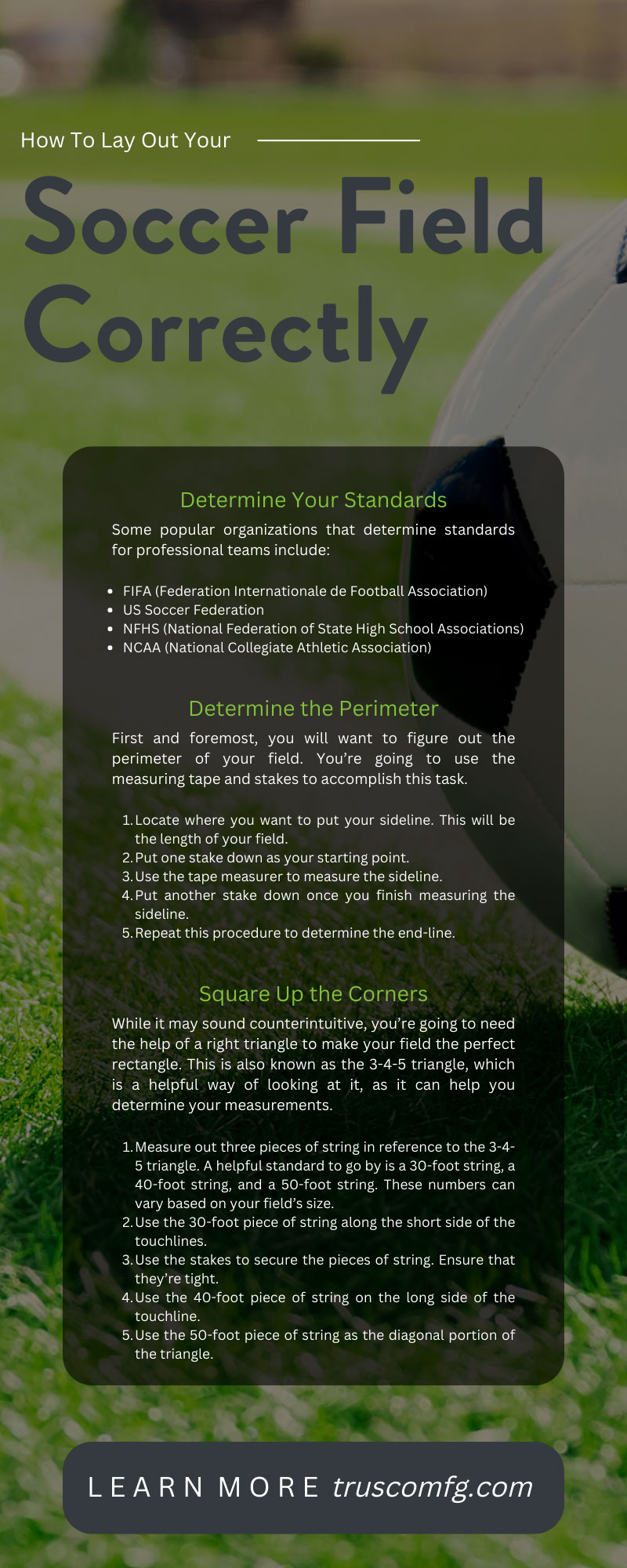
Lining fields correctly is an important job that lets athletes play sports by the rules. There is plenty of debate among athletic coaches and maintenance directors about how to correctly lay out a soccer field. The process involves quite a bit of math, so it’s important to prepare before painting any field marking lines. Rushing the process can result in mistakes, and correcting them takes time.
Determine Your Standards
To know how to lay out your soccer field correctly, choose standards to follow to determine the proper measurements. Different soccer organizations have slight variations, which affects how you lay out the pitch.
Some popular organizations that determine standards for professional teams include:
- FIFA (Federation Internationale de Football Association)
- US Soccer Federation
- NFHS (National Federation of State High School Associations)
- NCAA (National Collegiate Athletic Association)
Professional soccer fields regulated by FIFA are anywhere from 110–120 yards long by 70 to 80 yards wide.
You will likely base your standards on the age group you’re lining the field for. Younger children require a smaller field to adapt the game to their size, making it age appropriate. High school students follow the standards set by the NFHS, while college students adhere to the NCAA.
Study Diagrams
Studying soccer field diagrams before you consider painting any part of the field is important. This best practice will ensure you make fewer mistakes while doing the job. You should familiarize yourself with the overall layout.
Important areas to note are the following:
- Sideline (touchline)
- End-line (touchline)
- Corner arc
- Goal box
- Penalty box
- Penalty arc
- Center circle
- Halfway line
Then you should note the standards you set for your soccer team, as this will impact the size of each field marking. Since there can be considerable variation, you can download a blank diagram and write your own measurements along each area. Alternatively, you can look up a diagram for your specific age group as a quick way to access the information you need.
Purchase Tools and Painting Equipment
You’ll need some tools and equipment to get the job done. Let’s look at some of the essentials, so you can work efficiently.
Tools
Some handy tools to assist in lining the field include:
- String or cables (500–700 yards, depending on your field’s size)
- 4 300-foot tape measures
- 24 six-inch stakes
- Hammers
Painting Equipment
In terms of painting, we recommend investing in field striping machinesfor the bulk of your lines. While you could rely on aerosol cans or paint sticks alone, the equipment used by the professionals allows you to accomplish the job with much more ease. They are built to last, so they are worth the money.
Field striping machines have dual spray tips, giving you even coverage. They also come with handheld spray attachments to handle the arcs on a soccer field. You’ll likely have to go over your lines several times when using aerosol or paint cans alone.
Assemble a Team
The next step in lining the soccer field is assembling a team of helpers. We recommend making this at least a two-person job, though you can have a larger team to get the job done faster. You should have an easy way to communicate on the field for bigger groups, so keep your smartphones handy.
Designing the Field
With your team assembled and your tools ready, you can finally begin designing the soccer field. It’s best to work section by section when you’re tackling the job.
Determine the Perimeter
First and foremost, you will want to figure out the perimeter of your field. You’re going to use the measuring tape and stakes to accomplish this task.
- Locate where you want to put your sideline. This will be the length of your field.
- Put one stake down as your starting point.
- Use the tape measurer to measure the sideline.
- Put another stake down once you finish measuring the sideline.
- Repeat this procedure to determine the end-line.
Square Up the Corners
Once you figure out the sideline and end-line, you should have the perimeter of the field. Your tape measures should be shaped like an L.
The next step you’re going to want to take is squaring up the corners of the soccer field. You’ll use stakes and string to accomplish this task.
While it may sound counterintuitive, you’re going to need the help of a right triangle to make your field the perfect rectangle. This is also known as the 3-4-5 triangle, which is a helpful way of looking at it, as it can help you determine your measurements.
- Measure out three pieces of string in reference to the 3-4-5 triangle. A helpful standard to go by is a 30-foot string, a 40-foot string, and a 50-foot string. These numbers can vary based on your field’s size.
- Use the 30-foot piece of string along the short side of the touchlines.
- Use the stakes to secure the pieces of string. Ensure that they’re tight.
- Use the 40-foot piece of string on the long side of the touchline.
- Use the 50-foot piece of string as the diagonal portion of the triangle.
With this process done, you should now have a clear idea of how the corner of your field should look.
Repeat and Connect
Now that you have figured out the perimeter on one side, you can repeat the process to determine the other side of the soccer field. Use the tape measures and stakes again to set this up.
Paint the Sidelines and End-Lines
With the foundation of the soccer field established, you’re ready to start painting some lines. You’ll use the tape measures as a guideline and paint along the inside of the field. This is where we recommend using the striping machine to get the job done.
Make Defining Field Marks
While one person is doing the lines for the field’s perimeter, the other can start making defining marks. This will help you determine where important parts of the field will be located. You can use spray paint, a paint stick, or an attachment on the striping machine for this portion of the process.
- Check your diagram to refer to the measurements of your field.
- Begin by lining the sidelines. This will allow you to see where the halfway line will be.
- On the end lines, make marks to let you determine the goal and penalty box.
Use Strings and Stakes To Create Important Areas
To help you see where the center circle will be, use the strings and stakes to determine the halfway line. Hammer those into the ground where your markings are located on the sideline.
You will also want to repeat similar processes when you’re making your goal and penalty box. This will help ensure accuracy when it’s time to paint.
Paint the Remaining Lines
Finally, you can paint all the remaining lines to make the boxes using the strings as a guideline. You can also paint the arcs and circles now that it’s properly laid out.
Your organization can feel proud about its soccer field when you take the time to prepare. Consider choosing Trusco Manufacturing for quality painting equipment to help you do the job right.

